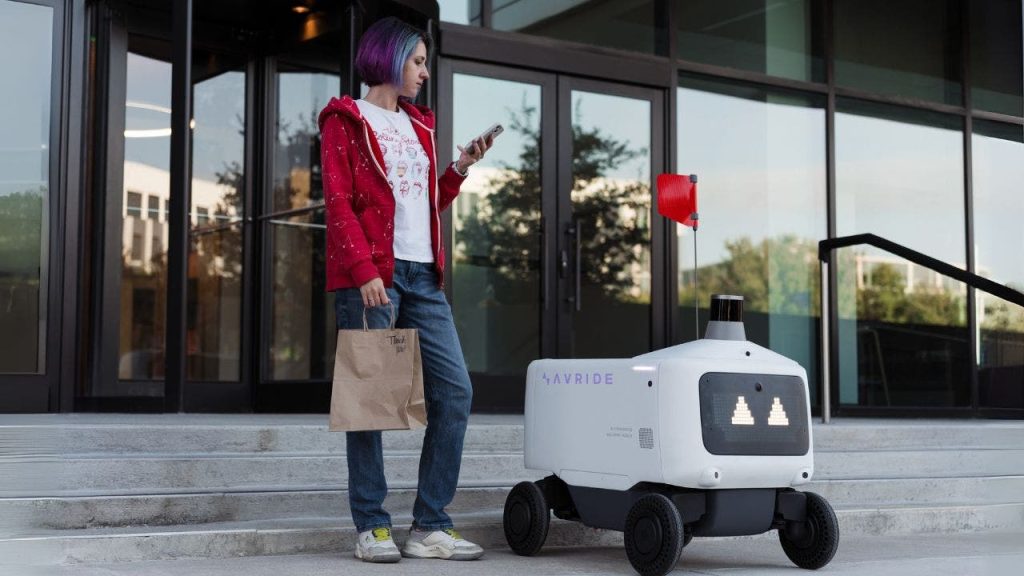Uber Eats is making strides into the future of food delivery with its introduction of autonomous delivery robots. These compact machines, developed in partnership with Avride, are already operational in several U.S. cities, including Austin and Jersey City. They offer a unique advantage by handling the last leg of food deliveries, providing a blend of efficiency and innovation that could soon transform how people receive their meals.
| Article Subheadings |
|---|
| 1) Understanding Uber Eats Delivery Robots |
| 2) Current Locations of Robot Deliveries |
| 3) The Delivery Process Explained |
| 4) The Reasons Behind Robot Deliveries |
| 5) Privacy Concerns and Robot Operation |
Understanding Uber Eats Delivery Robots
Uber Eats utilizes small, four-wheeled robots designed for the final stretch of food delivery. About the size of a carry-on suitcase, these robots can navigate sidewalks at speeds up to five miles per hour, catering to urban culinary demands effectively. Each robot is capable of carrying up to 55 pounds of food or beverages, accommodating larger orders, including pizzas and multiple drink bottles.
Equipped with state-of-the-art technology like LIDAR, cameras, and ultrasonic sensors, these robots can detect obstacles from as far as 200 feet away. They can identify traffic signals and adeptly navigate through crowded sidewalks, ensuring that deliveries are executed efficiently and safely. Furthermore, they are operational around the clock, regardless of the weather conditions—be it rain or shine.
Robots come with secure compartments that only unlock when the customer uses the Uber Eats app to access their orders. With interchangeable batteries and a functional life of up to 12 hours, they are designed for continuous service, thereby enhancing the overall delivery experience.
Current Locations of Robot Deliveries
Currently, Uber Eats robots are active in multiple U.S. cities. Austin, Texas, was the pioneer for this program, followed by Jersey City in New Jersey which has implemented the robots in neighborhoods including Hamilton Park and Historic Downtown. Dallas is poised to join in the robot delivery phenomenon soon.
Additional cities in Ohio are also part of the rollout, which aims to see hundreds of delivery robots operational by the end of 2025. As Uber Eats continues its expansion, residents in various urban areas may find themselves receiving food deliveries from these innovative robotic couriers.
The Delivery Process Explained
For users in participating locations, opting for a robot delivery is becoming a seamless part of the ordering process. When placing an order through the Uber Eats app, customers can select a delivery robot as their method of delivery. Once chosen, the app dispatches a robot to the user’s indicated location, where they will receive a notification upon arrival.
The process is straightforward; the user simply utilizes the app to unlock the robot’s secure compartment and collects their delivery. These robots are designed not only for meal deliveries but also for transporting groceries and small packages, offering additional versatility to the service.
The Reasons Behind Robot Deliveries
The decision to incorporate autonomous robots into the delivery process stems from the evolving demands of Uber Eats’ service. With over 31 million active users in the U.S., the company is under constant pressure to deliver services that are not only faster but also more cost-effective and reliable. The advent of robots addresses these necessities perfectly.
Autonomous delivery systems negate delays caused by traffic and do not depend on human drivers, which allows them to perform efficiently during short trips, particularly in urban settings. This technological advancement is expected to lower delivery fees, enhance reliability, and contribute to safety by navigating city streets using built-in sensors and traffic rule programming.
Privacy Concerns and Robot Operation
Uber Eats has implemented careful measures regarding user privacy as part of integrating robot delivery. These robots do not store sensitive personal information, such as payment details or delivery addresses. Instead, they handle only the critical information needed for pickup and delivery, maintaining a strict separation from personal identities.
Furthermore, any sensor data collected during operations is anonymized and used exclusively to enhance the robotics technology. The cameras installed on these robots are designed to blur out faces and license plates to prevent any infringement on personal privacy. By establishing these safeguards, Uber aims to foster user trust while advancing their delivery innovations.
| No. | Key Points |
|---|---|
| 1 | Uber Eats robots are compact, four-wheeled machines designed for efficient food delivery. |
| 2 | The robots currently operate in multiple U.S. cities, including Austin and Jersey City. |
| 3 | Users can select robot delivery as an option through the Uber Eats app. |
| 4 | The robots are designed to improve efficiency while being cost-effective for users. |
| 5 | Privacy measures ensure that robots do not store personal information during delivery operations. |
Summary
The introduction of autonomous delivery robots by Uber Eats underscores a pivotal transition in the food delivery industry. As they roll out in cities across the U.S., these robots promise faster, safer, and more reliable services. By addressing privacy concerns and enhancing operational efficiency, Uber Eats is setting a new standard for delivery services that could reshape consumer experiences in the future.
Frequently Asked Questions
Question: How do I know if robot delivery is available in my area?
If you reside in a participating city, the option to choose a robot during checkout in the Uber Eats app will be available. Users can inquire with Uber Eats for information regarding specific locations.
Question: What types of items can the delivery robots carry?
The delivery robots are capable of transporting not only food orders but also small packages and groceries, making them versatile for various delivery needs.
Question: How does Uber guarantee the privacy of its users with these robots?
Uber Eats robots are designed to not store personal user information, focusing exclusively on pickup and delivery locations while anonymizing sensor data to safeguard privacy.


